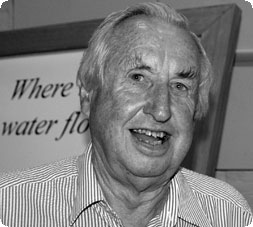 |
 |
|
Tony VidalTony Vidal was the son of a World War 1 soldier settler, in the Griffith district. He began a cadetship with the Water Conservation and Irrigation Commission in 1940. After several years in the Australian Air Force during world War II he returned to the Commission, completing his engineering degree and moved to Deniliquin in 1951, overseeing construction of the Lawson Syphons. INTERVIEW TRANSCRIPTThe following text is based on an edited transcript of an interview recorded with Mr Tony Vidall in March 2005. Key topics: Lawson Syphon construction techniques, concrete, migrant workers, Bonegilla, morale, pay, skills, pre-cast concrete I was there as the site engineer, working initially under Eric Nicholas, who was a great boss. He was perhaps more a theorist than was needed. I got in amongst the boys and made it all work, I think. Eventually, he [Eric Nicholas] took over from Bill Shattock as the resident engineer and he moved into the office in town, and I ran it out there by myself. Well, I got on to this job I think in April '51, and I was certainly there when it opened in April '55, but then we went on and did this pre-cast work, and I think I was here for a couple of years after that. Design and construction The design of the scheme and the construction method was basically done by the Irrigation Commission people in Sydney back in the 1930s, and our job was to make it happen. They didn't come near us though. The first thing, of course, was to make sure that the sheet piling was going in the right direction, or possibly before that even, the big timber piles in the thing, to see they were heading in the right direction. We then put down a concrete slab the full width of the trench - once it was dug out - the full width of it, and on that, as a surveyor, we were able to mark the line for these - for the rest of the work to go on. Jack Canobi was the pile driving man or the heavy timber installation. Ron Butcher was the general foreman apart from what Canobi was doing, and he was also the foreman/carpenter. We would discuss all the time just what was going to happen and how it was going to happen. And also I did all the surveying work that was necessary to make sure that one end connected up with the other at the right place. Everything really was done on site. Height-wise and direction-wise - once the concrete slab was down, it was pretty straightforward sort of stuff. The concrete in the structure was pumped into position by a Blaw Knox concrete pump. To the best of my knowledge that was the first one in Australia. It may not have been. It was certainly the first one in the bush. Feeding that was pretty primitive, actually, but there was a batch plant set up which was designed to the best of my knowledge by Eric Nicholas, and that worked very well. The structure consisted of two big hoppers, one with sand and the other with coarser aggregate, and that was led by chute into either of two concrete mixers. The people running the mixers, like Johnny Boyce, would add three bags of cement to each batch. They would weigh in the sand, they would weigh in the aggregate, they would put the correct amount of water into the mixer, mix it up, and then discharge it into the Blaw Knox. When the concrete aggregate came to the Deniliquin railway siding from I think Seymour or Shepparton, somewhere in Victoria, if we didn't unload those rail wagons quickly we'd be charged demurrage. So, it was every truck that we could find plus the necessary people would be in there and unload those rail trucks, basically by hand. Migrant workers arrive I guess it was through some government [initiative] that we got these 70-odd people from Bonegilla, the displaced persons, as we called them in those days. You'd call them refos if you liked, but it's not politically correct. But these people arrived one day and lined up and we discovered that there were two of them that could speak pretty good English and they became our link to these blokes. One was Jerry Hrasky. The other bloke's name is Tibor [Jack] Szendroe. And he worked pretty closely with me for two or three years. We had a concrete testing laboratory too, what they call quality control now, and he was the man that did the concrete testing for me. They were all happy to be out of Europe. I think the people that came from Bonegilla knew that if they didn't behave themselves, they'd be back there, and they were all, as far as I'm concerned, willing to learn and have a go, and from memory, they picked up pretty quickly, what they had to do. To the best of my knowledge morale was marvellous. I wasn't living on site, I don't know what happened after work, but I don't remember ever hearing any real complaints, except one I want to tell you about. In those days the fitters were paid by the week. The carpenters were paid by the week. The labourers were paid by the hour, depending on what they were doing, so the rate changed. And any one labourer could be doing four different jobs in the one day for different rates of pay. One [job might be] more skilled than the other; I don't know how much they were getting, but they might have been getting eight pence halfpenny or eight pence three farthings an hour, whatever it was. But it was all laid down, what rate for what particular job. And the ganger would meticulously note all this down for each day. The timekeeper, Joe Hetherington, would come, take it from the ganger's book and put it into his little book, and eventually it would find its way into the clerical people and they would multiply it all out. Some of our migrant people couldn't speak very good English, but when they got their timesheet or their pay, they knew to the penny how much they should be getting, and there were some arguments over that. And I think after a year with the gangers and the foremen, we decided, let's cut some of this rubbish out, and that's the rate for the morning and that's the rate for the afternoon, and there was a lot less bookwork, and it was always the highest [rate] of course. The pay was all right. I guess my appreciation of the blokes that worked there has grown as the years go by and I've done other little things and what those blokes did - virtually no complaints, no strikes, except worrying about that penny that was out of their pay. And it was very satisfying, and it still is. Some key staff JackWoods who was a foreman, used to be up an hour before everyone else in the morning, and he'd go down and get the steam up so that when the pile drivers arrived, they didn't sit around for half an hour waiting for the steam to come up. A bloke named Bill Lawford, who was the mechanical foreman, who I think everyone will agree wasn't very well educated, but he could make any plant item talk, but he could get a diesel engine working properly just by ear, where other people needed instruments. He had a leading hand, I think he was Harry Simmons, who could do anything else, especially I think with compressed air tools. We - we used compressed air there rather than petrol-driven stuff. The compressors were pretty pathetic sort of things but they worked. The other workshop bloke I particularly remember is Fred Lance, who was I think classified as a boilermaker, but he was also a welder and he was a blacksmith, and anything Harry Simmons couldn't do, Freddy could d. And among other things, this was Adrian's side of it, he used to build up the teeth for the dragline buckets, which wear out, especially with the digging in sand, they just wear down to nothing. In they'd come, and Freddy had worked out the correct sort of welding rods to use, and he'd build those things up and away they'd go again. From memory, there were three [floods]. The coffer dams were over-topped by the river, and the whole thing was sort of out of action until the river went down and everybody was satisfied that it wasn't going to sneak back up again tonight, and then started pumping there. Pre-casting bridge decks Later on, after the syphon was opened, we were given the job of pre-casting some bridge decks. Now, that could have been an innovation. I'm not aware of anyone else outside the cities building pre-cast concrete bridge decks at that time. Anyway, I went to Freddy with the drawings of how these decks were supposed to finish up. He said, "Righto", and he built the formwork for it, starting with sheets of 8 inch steel or whatever it was which he would pretty meticulously cut to shape and length and whatever and weld them together, and it all worked. We were able to order and receive a Coles mobile crane, which was a fairly radical sort of thing for this part of the world, and it was used when it came time to put these - these planks onto the bridge abutments, and these things weighed five tons each, and this particular crane could install them with practically a flat gib, which is something. |
You'll need to get the Flash Player to hear the audio. |
|
| sitemap • credits
& references • copyright • local
history links • contact & contribute • VISITORS |
||
